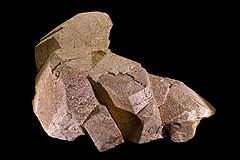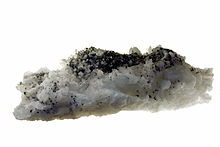- Orthoclase
-
Orthoclase 
General Category Silicate mineral Chemical formula KAlSi3O8 Identification Color Colorless, Greenish, Grayish yellow, White, Pink Crystal habit Can be anhedral or euhedral. Grains are commonly elongate with a tabular appearance. Crystal system Monoclinic (2/m)
space group C2/mTwinning Typically displays carlsbad twinning. Baveno and manebach twins have also been reported in orthoclase. Cleavage Has perfect cleavage on {001} and good cleavage on {010}. Cleavages intersect at 90°. It can be difficult to see cleavage in thin section due to orthoclase's low relief. Mohs scale hardness 6 (defining mineral) Luster Vitreous, pearly on cleavage surfaces Streak white Diaphaneity Transparent to translucent Specific gravity 2.55–2.63 Optical properties Biaxial (-), 2V = 65–75 Refractive index nα = 1.518–1.520
nβ = 1.522–1.524
nγ = 1.522–1.525Birefringence 0.0050–0.0060 Dispersion relatively strong Extinction parallel to cleavage Diagnostic features Distinguishable from microcline by a lack in gridiron twinning. Distinguishable from sanidine by a larger 2Vx. Other characteristics Low negative relief References [1][2][3] Orthoclase (endmember formula KAlSi3O8) is an important tectosilicate mineral which forms igneous rock. The name is from the Greek for "straight fracture," because its two cleavage planes are at right angles to each other. Alternate names are alkali feldspar and potassium feldspar. The gem known as moonstone (see below) is largely composed of orthoclase.
Contents
Formation and subtypes
Orthoclase is a common constituent of most granites and other felsic igneous rocks and often forms huge crystals and masses in pegmatite.
Typically, the pure potassium endmember of orthoclase forms a solid solution with albite, the sodium endmember (NaAlSi3O8), of plagioclase. While slowly cooling within the earth, sodium-rich albite lamellae form by exsolution, enriching the remaining orthoclase with potassium. The resulting intergrowth of the two feldspars is called perthite.
 Adularia with pyrite incrustations.
Adularia with pyrite incrustations.
The higher-temperature polymorph of orthoclase is sanidine. Sanidine is common in rapidly cooled volcanic rocks such as obsidian and felsic pyroclastic rocks, and is notably found in trachytes of the Drachenfels, Germany. The lower-temperature polymorph of orthoclase is microcline. Adularia is found in low temperature hydrothermal deposits, in the Adula Mountains of Switzerland. The largest documented single crystal of othoclase was found in Ural mountains, Russia. It measured ~10×10×0.4 m3 and weighed ~100 tons.[4]
Uses
Together with the other potassium feldspars orthoclase is a common raw material for the manufacture of some glasses, some ceramics, such as porcelain, and as a constituent of scouring powder.
Some intergrowths of orthoclase and albite have an attractive pale lustre and are called moonstone when used in jewellery. Most moonstones are translucent and white, although grey and peach-colored varieties also occur. In gemology, their lustre is called adularescence and is typically described as creamy or silvery white with a "billowy" quality. It is the state gem of Florida.
The gemstone commonly called rainbow moonstone is more properly a colourless form of labradorite and can be distinguished from "true" moonstone by its greater transparency and play of colour, although their value and durability do not greatly differ.
See also
References
- ^ Mindat
- ^ Handbook of Mineralogy
- ^ Webmineral
- ^ P. C. Rickwood (1981). "The largest crystals". American Mineralogist 66: 885–907. http://www.minsocam.org/ammin/AM66/AM66_885.pdf.
Categories:- Potassium minerals
- Aluminium minerals
- Tectosilicates
- Monoclinic minerals
- Feldspar
Wikimedia Foundation. 2010.
